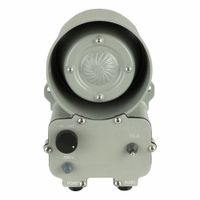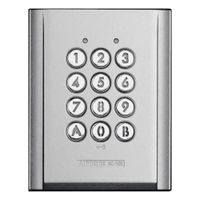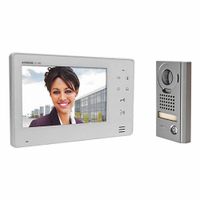Call +(254) 703 030 000 / 751 483 999 / 721 704 777
.....Read More
Frequently Asked Questions
What is an intercom system and how does it work?
An intercom system is a communication device that allows for two-way audio or audio-visual communication within a building or a defined area. It is commonly used in residential, commercial, and industrial settings to facilitate communication between different rooms or areas without the need for a telephone network.
Intercom systems consist of a central control panel and multiple substations or units. The central panel is typically located at a main entrance or security desk, while substations are placed in various rooms or locations. These systems can be wired or wireless, with wired systems using physical cables to connect units and wireless systems relying on radio frequencies or Wi-Fi.
Basic intercom systems provide audio communication, allowing users to speak and listen through a microphone and speaker setup. More advanced systems include video capabilities, featuring cameras and monitors for visual interaction. Some intercoms also integrate with door entry systems, enabling users to unlock doors remotely after verifying a visitor's identity.
Intercom systems operate by transmitting signals between the central panel and substations. When a user presses a button on a substation, it sends a signal to the central panel, alerting the recipient. The recipient can then respond, establishing a communication link. In video intercoms, the camera activates to provide a visual feed.
Modern intercom systems may include additional features such as integration with smartphones, allowing users to communicate and control the system remotely. They may also support integration with other security systems, such as CCTV and alarm systems, enhancing overall security and convenience.
In summary, intercom systems are versatile communication tools that enhance security and convenience by enabling efficient communication within a specified area.
What are the different types of intercom systems available?
1. **Wired Intercom Systems**: These systems use physical wiring to connect intercom stations. They are reliable and offer high-quality sound but can be expensive and complex to install, especially in existing buildings.
2. **Wireless Intercom Systems**: These systems use radio frequencies or Wi-Fi to connect devices. They are easier to install and more flexible than wired systems, making them ideal for retrofitting. However, they may face interference issues and have limited range compared to wired systems.
3. **Video Intercom Systems**: These systems include a camera and a display screen, allowing users to see and communicate with visitors. They enhance security by providing visual identification and are commonly used in residential and commercial buildings.
4. **Audio Intercom Systems**: These are the most basic type, allowing voice communication between different stations. They are cost-effective and suitable for simple communication needs.
5. **IP Intercom Systems**: These systems use internet protocol to transmit audio and video signals over a network. They offer advanced features like remote access, integration with other smart devices, and scalability, making them suitable for modern smart homes and businesses.
6. **Carrier-Current Intercom Systems**: These systems use the building's existing electrical wiring to transmit signals. They are easy to install but may have limited range and sound quality.
7. **Mobile/Smartphone Intercom Systems**: These systems use mobile apps to allow communication through smartphones. They offer convenience and remote access, making them popular in smart home setups.
8. **Two-Way Radio Intercom Systems**: These portable systems use radio frequencies for communication, ideal for large areas like construction sites or events where mobility is essential.
How do I install an intercom system in my home or office?
1. **Plan the System**: Determine the type of intercom system (wired or wireless) and the number of units needed. Consider the layout of your home or office and decide on the locations for the master station and sub-stations.
2. **Purchase the System**: Buy an intercom system that fits your needs. Ensure it includes all necessary components like master stations, sub-stations, power supply, and wiring (if wired).
3. **Gather Tools**: Collect tools such as a drill, screwdriver, wire stripper, fish tape, and a voltage tester.
4. **Install Master Station**: Choose a central location for the master station. If wired, drill holes and run wires through walls or ceilings. Mount the master station using screws and connect it to the power supply.
5. **Install Sub-Stations**: Position sub-stations in desired locations. For wired systems, run wires from the master station to each sub-station. Use fish tape to guide wires through walls. Mount sub-stations and connect wires.
6. **Connect Wiring**: For wired systems, connect wires according to the manufacturer's instructions. Typically, this involves connecting corresponding wires from the master station to each sub-station.
7. **Power the System**: Plug in the power supply and ensure all units are receiving power. For wireless systems, ensure batteries are installed or units are charged.
8. **Test the System**: Test each unit to ensure clear communication. Adjust volume settings and troubleshoot any issues, such as poor sound quality or connectivity problems.
9. **Secure and Conceal Wiring**: For wired systems, secure wires with clips and conceal them with cable covers or within walls to maintain aesthetics.
10. **Finalize Installation**: Ensure all units are securely mounted and functioning properly. Make any necessary adjustments to settings or positioning.
What are the benefits of using a video intercom system?
A video intercom system offers numerous benefits, enhancing security, convenience, and communication. Firstly, it significantly boosts security by allowing users to visually verify the identity of visitors before granting access, reducing the risk of unauthorized entry. This visual confirmation is particularly valuable in residential buildings, offices, and gated communities.
Secondly, video intercoms enhance convenience. They enable remote communication, allowing users to interact with visitors without physically being at the door. This is especially useful for individuals with mobility issues or for those who are busy with other tasks. Many modern systems integrate with smartphones, enabling users to manage access from anywhere, adding a layer of flexibility and control.
Thirdly, these systems improve communication within a building. They facilitate seamless interaction between different units or floors, making it easier to convey messages or coordinate activities without the need for physical movement. This is beneficial in both residential and commercial settings.
Additionally, video intercom systems often come with recording capabilities, providing a record of visitors and interactions. This feature can be crucial for security audits or investigations, offering peace of mind to users.
Moreover, the presence of a video intercom system can deter potential intruders, as the visible camera acts as a deterrent. It signals that the premises are monitored, reducing the likelihood of criminal activity.
Finally, video intercom systems can increase property value. They are considered a modern amenity, appealing to potential buyers or tenants who prioritize security and convenience. This can be a significant advantage in competitive real estate markets.
In summary, video intercom systems offer enhanced security, convenience, improved communication, deterrence of crime, and potential property value increase, making them a valuable addition to any property.
How do I troubleshoot common issues with intercom systems?
1. **No Power**: Check the power supply to ensure the intercom system is plugged in and receiving power. Inspect the circuit breaker or fuse box for tripped breakers or blown fuses.
2. **No Sound**: Verify the volume settings on both the master and sub-stations. Ensure the mute function is not activated. Check wiring connections for any loose or damaged wires.
3. **Poor Sound Quality**: Inspect for interference from other electronic devices. Ensure all connections are secure and wires are not frayed. Clean the microphone and speaker openings to remove dust or debris.
4. **Intermittent Operation**: Examine the wiring for any signs of wear or damage. Check for loose connections at terminals. Ensure the system is not overheating by providing adequate ventilation.
5. **No Response from Sub-Station**: Confirm that the sub-station is powered on. Check the wiring between the master and sub-stations for continuity. Test the sub-station with a multimeter to ensure it is functioning.
6. **Buzzing or Static Noise**: Identify any sources of electrical interference nearby. Ensure all cables are properly shielded. Tighten any loose connections and replace any damaged cables.
7. **Door Release Not Working**: Verify the door release mechanism is receiving power. Check the wiring connections between the intercom and the door release. Test the door release with a multimeter.
8. **Video Issues (for Video Intercoms)**: Ensure the camera lens is clean and unobstructed. Check the video cable connections for any damage. Adjust the camera angle if necessary.
9. **System Not Ringing**: Confirm the ringer volume is turned up. Check the wiring for any disconnections. Test the ringer circuit with a multimeter.
10. **Consult the Manual**: Refer to the user manual for specific troubleshooting steps related to your model. Contact customer support if issues persist.
Can intercom systems be integrated with other security systems?
Yes, intercom systems can be integrated with other security systems. Modern intercom systems often come with advanced features that allow them to be seamlessly connected with various security components, enhancing overall security and communication capabilities.
Integration with access control systems is common, allowing intercoms to manage entry points by verifying identities before granting access. This can be done through keypads, card readers, or biometric scanners. Video intercoms can be linked with CCTV systems, providing visual verification and recording of interactions at entry points. This integration enhances monitoring and can be crucial for security audits.
Intercom systems can also be connected to alarm systems. In case of an emergency, the intercom can trigger alarms or send alerts to security personnel, ensuring a rapid response. Some systems allow for integration with fire alarms, enabling communication during evacuations.
Smart home and building automation systems can also incorporate intercoms, allowing users to control them via smartphones or other smart devices. This integration can include features like remote unlocking of doors or receiving notifications when someone is at the door.
Network-based intercoms can be part of a larger IP-based security infrastructure, facilitating centralized management and monitoring. This allows for scalability and flexibility in expanding security measures as needed.
Overall, the integration of intercom systems with other security systems enhances security, improves communication, and provides a more comprehensive approach to managing building access and safety.
What are the costs associated with installing and maintaining an intercom system?
The costs associated with installing and maintaining an intercom system can be categorized into several components:
1. **Initial Equipment Costs**: This includes the price of the intercom units themselves, which can vary based on the type (audio-only, video, wireless, or wired). Basic audio systems are generally cheaper, while video intercoms and smart systems with advanced features like mobile app integration are more expensive.
2. **Installation Costs**: Professional installation fees depend on the complexity of the system and the building's infrastructure. Wired systems typically require more labor and time, increasing costs, whereas wireless systems might be less expensive to install.
3. **Cabling and Infrastructure**: For wired systems, additional costs for cabling, conduits, and any necessary modifications to the building's structure should be considered.
4. **Licensing and Permits**: Depending on local regulations, there may be costs associated with obtaining necessary permits or licenses for installation.
5. **Maintenance Costs**: Regular maintenance is essential for system reliability. This includes periodic inspections, software updates, and repairs. Maintenance contracts with service providers can offer predictable costs.
6. **Repair and Replacement Costs**: Over time, components may fail or become obsolete, necessitating repairs or replacements. This can include replacing handsets, cameras, or upgrading software.
7. **Training and Support**: Initial training for users and ongoing support can incur additional costs, especially for complex systems.
8. **Energy Costs**: Intercom systems consume electricity, contributing to ongoing operational costs.
9. **Integration Costs**: If the intercom system needs to be integrated with other security systems, additional costs for compatibility and configuration may arise.
10. **Upgrades and Scalability**: As needs change, upgrading or expanding the system can incur additional costs.
Overall, the total cost will depend on the system's complexity, the building's requirements, and the level of service desired.




